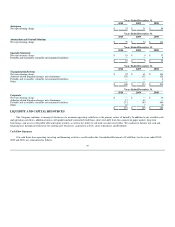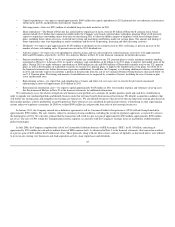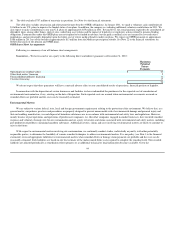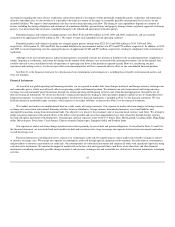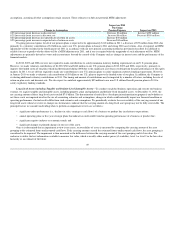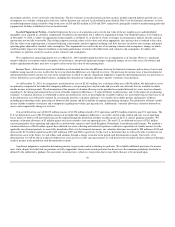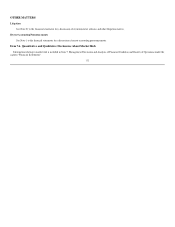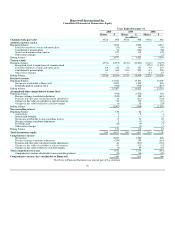Honeywell 2010 Annual Report Download - page 52
Download and view the complete annual report
Please find page 52 of the 2010 Honeywell annual report below. You can navigate through the pages in the report by either clicking on the pages listed below, or by using the keyword search tool below to find specific information within the annual report.
assumptions, assuming all other assumptions remain constant. These estimates exclude any potential MTM adjustment:
Change in Assumption
Impact on 2011
On-Going
Pension Expense Impact on PBO
0.25 percentage point decrease in discount rate Decrease $8 million Increase $390 million
0.25 percentage point increase in discount rate Increase $6 million Decrease $380 million
0.25 percentage point decrease in expected rate of return on assets Increase $30 million —
0.25 percentage point increase in expected rate of return on assets Decrease $30 million —
On-going pension expense for all of our pension plans is expected to be approximately $110 million in 2011, a decrease of $79 million from 2010, due
primarily to a voluntary contribution of $1 billion in cash to our U.S. pension plans in January 2011 and strong 2010 asset returns. Also, if required, an MTM
adjustment will be recorded in the fourth quarter of 2011 in accordance with our new pension accounting method as previously described. It is difficult to
reliably forecast or predict whether there will be a MTM adjustment in 2011, and if one is required what the magnitude of such adjustment will be. MTM
adjustments are primarily driven by events and circumstances beyond the control of the Company such as changes in interest rates and the performance of the
financial markets.
In 2010, 2009 and 2008,we were not required to make contributions to satisfy minimum statutory funding requirements in our U.S. pension plans.
However, we made voluntary contributions of $1,000, $740 and $242 million to our U.S. pension plans in 2010, 2009 and 2008, respectively, primarily to
improve the funded status of our plans which had deteriorated during 2008 due to the significant asset losses resulting from the poor performance of the equity
markets. In 2011, we are still not required to make any contributions to our U.S. pension plans to satisfy minimum statutory funding requirements. However,
in January 2011 we made a voluntary cash contribution of $1 billion to our U.S. plans to improve the funded status of our plans. In addition, the Company is
evaluating additional voluntary contributions in 2011. The timing and amount of contributions may be impacted by a number of factors, including the rate of
return on plan assets and discount rate. We also expect to contribute approximately $55 million to our non-U.S. defined benefit pension plans in 2011 to
satisfy regulatory funding standards.
Long-Lived Assets (including Tangible and Definite-Lived Intangible Assets)—To conduct our global business operations and execute our business
strategy, we acquire tangible and intangible assets, including property, plant and equipment and definite-lived intangible assets. At December 31, 2010, the
net carrying amount of these long-lived assets totaled $7.0 billion. The determination of useful lives (for depreciation/amortization purposes) and whether or
not these assets are impaired involves the use of accounting estimates and assumptions, changes in which could materially impact our financial condition or
operating performance if actual results differ from such estimates and assumptions. We periodically evaluate the recoverability of the carrying amount of our
long-lived assets whenever events or changes in circumstances indicate that the carrying amount of a long-lived asset group may not be fully recoverable. The
principal factors we consider in deciding when to perform an impairment review are as follows:
• significant under-performance (i.e., declines in sales, earnings or cash flows) of a business or product line in relation to expectations;
• annual operating plans or five-year strategic plans that indicate an unfavorable trend in operating performance of a business or product line;
• significant negative industry or economic trends; and
• significant changes or planned changes in our use of the assets.
Once it is determined that an impairment review is necessary, recoverability of assets is measured by comparing the carrying amount of the asset
grouping to the estimated future undiscounted cash flows. If the carrying amount exceeds the estimated future undiscounted cash flows, the asset grouping is
considered to be impaired. The impairment is then measured as the difference between the carrying amount of the asset grouping and its fair value. We
endeavor to utilize the best information available to measure fair value, which is usually either market prices (if available), level 1 or level 2 in the fair value
hierarchy or an estimate of the future
49


